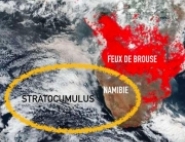Polder 1 Calibration
Geometrical performances:
Geometrical requirements regard registration errors between POLDER images:
- of the same spectral band, but acquired with different polarizers: multi-polarization registration error
- of the same sequence but different spectral bands: multi-spectral registration error
- of the same spectral band but different sequences in the same orbit: multi-angular registration error
- of the same spectral band but from different orbits: multi temporal registration error
The requirements 1 (0.1 pixel MAX) and 2 (0.2 pixel MAX) are met. The requirement 3 (0.2 pixel RMS), was not met (measurement gives 0.3 RMS), because of a small angular bias. The measurement of this bias has been obtained through in-flight geometrical calibration, and is now corrected using version 0.6 of geometrical calibration parameters. RMS multi angular registration error is now between 0.12 and 0.14. The multi-temporal registration errors are currently measured.
Radiometrical calibration:
Radiometrical in-flight calibration is achieved through a very large set of methods using well characterized natural targets such as:
- absolute calibration over molecular scattering,
- inter-band calibration over sunglint and clouds,
- interpixel and multitemporal calibration over desert sites,
- polarisation calibration over clouds and sunglint,
- interpixel calibration over clouds,
- water vapor channels calibration with radiosondes,
- inter-calibration with OCTS.
The use of all these methods has given very consistent results. Their consistency with pre-flight calibration is also excellent since no measurement indicates a change in absolute calibration greater than 5% in all spectral bands. This shows that the POLDER instrument is very stable.
In the Version 0.0, refering to the pre-launch calibration, all ![]() Ak are set to 1. For the Version 2.0, calibration values are:
Ak are set to 1. For the Version 2.0, calibration values are:
| Band | 443P | 443 | 490 | 565 | 670 | 763 | 765 | 865 | 910 |
| 0.965 | 0.970 | 0.995 | 1.035 | 1.030 | 1.023 | 1.037 | 1.050 | 1.027 |
The results are as follows:
- The calibration coefficients have been updated. The present accuracy of these absolute calibration coefficients is estimated to be better than 3-4%. This accuracy has been also validated through inter-calibration with OCTS. Still some uncertainty exists in the absolute calibration of the 443 nm channels. The work is ongoing to reach the challenging objective of 2-3% absolute calibration.
- In-flight inter-band calibration is better than 1% (except maybe for 443P spectral band).
- Polarization rates can be determined with better than 1% accuracy.
- High frequency relative calibration between different elementary detectors in the CCD matrix did not change by more than 0.2%.
- Low frequency relative calibration could not be measured with enough accuracy, but there is no hint of a variation.
Radiometrical performances:
The strongest requirement in term of NeDR (given in normalized radiance unit) is less than 5 E-4 for low radiances, except for the polarized channels 443P for which the specification is 1E-3. The preflight performance budget (accounting for the photon, electronic noises and residual straylight correction associated with an average landscape radiance of 0.25) for an input radiance of 0.05 varies from 2 E-4 to 6 E-4 with the different channels.
Without a stable on-board source, measuring the radiometrical performances of POLDER is not easy because it seems to be no natural target with enough uniformity: all such measurements show that the performance is better than 1.5 E-3.
The only way to validate the pre-flight performance budgets is to compare the 443P and 443NP measurements which should be identical after radiometrical corrections. Standard deviation between the two measurements is better than the 443P requirement and a little worse than 443NP, as expected since the calibration method gives the quadratic mean of the two noises. We consider that pre-flight performance budgets are validated.
Conclusion:
All our measurements indicate that POLDER instrument is stable.
New coefficients have been introduced in the level 1 processing parameters and POLDER level 1 data have been reprocessed. Note that POLDER level 1 products are fully calibrated and georeferenced.
